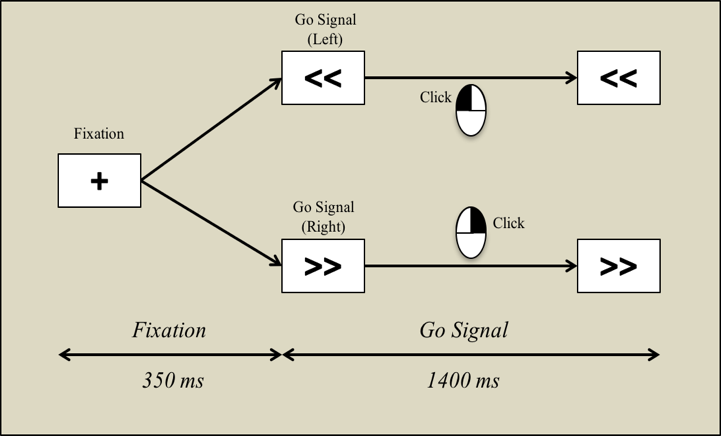Session Information
Date: Thursday, June 8, 2017
Session Title: Parkinson's Disease: Neuroimaging And Neurophysiology
Session Time: 1:15pm-2:45pm
Location: Exhibit Hall C
Objective: We investigated Parkinson’s disease (PD) patients during a functional MRI Choice Reaction Time (CRT) task and determined whether brain activations are altered by dopamine.
Background: The cognitive processes underlying the selection and execution of voluntary actions can be studied during a CRT task, where discrete stimuli prompt specific responses.
Methods: We studied 16 cognitively unimpaired PD (Level-II) and 15 age-matched controls (HC) during a CRT task, where participants pressed their index or middle finger in response to a left or right arrow (Go) stimulus, respectively [Figure]. PD patients were tested OFF (PD_OFF) and ON (PD_ON) dopaminergic meds. Between-group brain activation maps were generated for successful Go responses. We identified significant clusters of activation at a height threshold of p < 0.01, with FWE correction for multiple spatial comparisons at p < 0.05. We then correlated Go response percent signal change with Go reaction time.
Results: There were no between group differences in Go reaction time or task accuracy [Table]. During successful Go responses, HC showed more activation than PD_OFF in the bilateral putamen, whereas PD_OFF showed more activation than HC in the left insula. HC showed more activation than PD_ON in the bilateral amygdala. Further, PD_ON showed more activation than HC in multiple frontal regions, including the anterior cingulum, middle frontal gyrus, and the right pre-supplementary motor area. Finally, we looked at the effect of dopaminergic meds directly (PD_ON versus PD_OFF) and found that PD_ON showed activation normalization (i.e. similar activation to HC) in the bilateral putamen and left insula. In HC, bilateral putamen activation positively correlated with Go reaction time (right: r=0.62;p=0.01/left: r=0.54;p=0.04). There were no significant correlations in PD_OFF or PD_ON.
Conclusions: In HC, putamen activation predicts reaction time during a CRT task. Unmedicated PD patients lose this critical putamen activation, but appear to generate similar behavioral results as HC by shifting activation to the insula. Dopamine then normalizes this shift, allowing patients to engage the putamen, but also hyper-activates frontal regions. Together, our data provide further evidence that PD patients engage alternate or compensatory brain regions to maintain normal cognitive performance, and that these regions might be further modulated by dopaminergic meds.
References: Hughes, L. E., Barker, R. A., Owen, A. M., Rowe, J. B. (2010), ‘Parkinson’s Disease and Healthy Aging: Independent and Interacting Effects on Action Selection’, Human Brain Mapping, 31(12), pp. 1886 – 1899.
Litvan, I., Goldman, J. G., Tröster, A. I., Schmand, B. A., Weintraub, D., Petersen, R. C., … & Aarsland, D. (2012), ‘Diagnostic Criteria for Mild Cognitive Impairment in Parkinson’s Disease: Movement Disorder Society Task Force guidelines’, Movement Disorders, 27(3), pp. 349-356.
To cite this abstract in AMA style:
J. Kim, K. Zhang, S. YorkWilliams, M. Ua Cruadhlaoich, V. Menon, K. Poston. Dopamine Normalizes Putamen to Insula Activation Shift During Choice Reaction Time Task in PD [abstract]. Mov Disord. 2017; 32 (suppl 2). https://www.mdsabstracts.org/abstract/dopamine-normalizes-putamen-to-insula-activation-shift-during-choice-reaction-time-task-in-pd/. Accessed December 20, 2025.« Back to 2017 International Congress
MDS Abstracts - https://www.mdsabstracts.org/abstract/dopamine-normalizes-putamen-to-insula-activation-shift-during-choice-reaction-time-task-in-pd/


